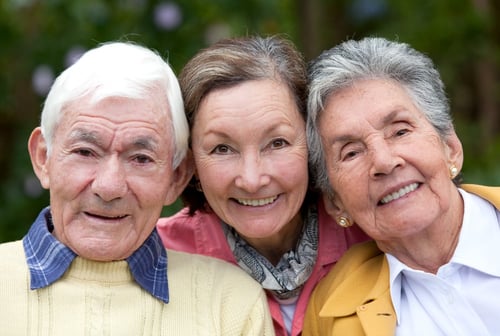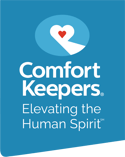When we go home for the holidays, we might see loved ones for more time than during the rest of the year. If you are concerned about some of the things you noticed, it might be time to take action.

2 Simple Questions Regarding Mobility
Mobility problems with seniors will often lead to other issues like incontinence. If you have trouble just getting up to walk, it can be difficult to get to the bathroom. Incontinence can lead to other health problems like skin breakdown or Urinary Tract Infections. Seniors often start down the path of losing their mobility when they stop doing the things they enjoy. It may be something like shopping or going for a nightly walk because they are too difficult. This can begin social isolation as they don't see friends and family as often and it becomes a snowball effect from there.
In a study by the University of Alabama in 2017, it was found that there are 2 simple indicators that are red flags for current or future health problems in seniors. Asking or noticing these two issues:
- For health or physical reasons, do you have difficulty climbing up 10 steps or walking one-quarter of a mile?
- Because of underlying health or physical reasons, have you modified the way you climb 10 steps or walk a quarter of a mile?
If you are unable to climb or walk normally, it’s a big indicator that you are on the road to losing your mobility. This often leads to loss of the freedom we all appreciate and the need to move to a facility that may provide the necessary services. One’s gait can also be a good indicator of underlying health. If you walk slower than 1 yard per second there is likely an issue. This would be less than 1 mile per hour. Most healthy people walk between 3 and 4 miles per hour. Another test is the Timed Up and Go test which is a measure of how likely it is that a senior might fall. This simple test can be done in less than a minute. The key measurements of the test are strength and balance. Healthy people need very little time to balance and begin to walk while persons at risk of falling often have difficulties with this simple task.
If these issues are found early, seeking the advice of a doctor to change the course of these events is a great place to start. The doctor may recommend Physical or Occupational Therapy. Initially working on balance and strength will begin the process of getting mobility back. Afterward, a program like Silver Sneakers can help keep people active and meet like-minded peers.
Loneliness
Every year the holidays roll around and Assisted Livings and Nursing Homes become hives of entertainment and cheer. As fast as it starts, it stops for most seniors. The families that were filling their living rooms have returned to their regular busy days, school, or living out of town. New technologies can help with that feeling of being alone in between visits. A company called Grandpad created the first tablet designed and dedicated to the senior market. They have put together the human interface to be simple and have as few choices as necessary to navigate. They also have built in safety so that vulnerable adults cannot go into the “dark” part of the web, or even have people accost them through the grandpad device. The tablet is now available at major retailers like Target or Best Buy. Social Isolation can lead to a variety of serious issues for seniors. It can lead to depression which can cause a person to not care about important elements of their health like medication, nutrition and safety.
A more human approach to senior loneliness is Interactive Caregiving. Having someone come to your home regularly that you know and develop a trust with. A Comfort Keeper Caregiver is trained in the 4 areas of Interactive Caregiving that help seniors develop a relationship with them while being given the opportunity to thrive in their homes. While there is no replacement for family, there is certainly a place for support from outside the family and having a person that is trained in getting seniors involved is a great place to start. Learn more about Interactive Caregiving by clicking here. The one thing you cannot get away from is how closely related the body and mind are. If you don’t have a positive attitude, it’s very difficult to want to eat or exercise. If we start with small steps--engaging the mind--then we get the opportunity work on things like nutrition and exercise.
Dementia
Families that are facing major issues from Dementia are often looking at many difficult decisions. The progressive nature of the disease makes it one that causes changes in how you interact personally with your loved one as well as their changing care needs. There is no “One Size Fits All” solution for these diseases.
We spend a lot of time training our Caregivers to be able to meet our clients needs where they are today--realizing that tomorrow things very likely will change. For instance, we might be dusting someone's bookcase but instead of focusing on the cleanest bookcase, we talk to them about the photos. Tomorrow, aroma may arouse fond memories. Some clients enjoy helping make a meal they made years ago for their family and have it ready for you when you arrive! It's often a combination of doing things together and evoking memories that help people adjust.
All agencies in Minnesota train their staff about Alzheimer's. We go beyond the standard training and we also send out our Caregiver Supervisor, or senior caregivers, into the home with your caregiver to help find the things that help satisfy each of our clients. We communicate our successes from one staff member to another through our Family Connect which helps them perform more seamlessly in providing care. It can also help clients and families see schedules and communicate with the office.
We have learned that in order to be successful we have to use Interactive Caregiving™ and a strong, supporting team to make a positive impact for the client and family. Click here for additional ideas.
Assisted Living or Home Care
When families discover their loved one is struggling living independently, they often think of Assisted Living facilities as being the key to solving many of the issues facing them. This really is not always the case as the facilities are not staffed like nursing homes and therefore they can’t help with some of the major issues people hope to find help for.
Often, families move their loved one to an Assisted Living because they are starting to fall at home. Most of the time, they believe their loved one will have all the help they need for negotiating the trips to the bathroom, kitchen or bedroom. In fact, the facilities are often understaffed and rely on fall monitors or periodic checks to find people that have fallen. People that fall often have to wait until Emergency Medical people arrive to help them up. It’s not exactly what people think they are getting when they decide to move to a facility. Falls are the single greatest issue causing seniors to lose their independence. According to the Centers for Disease Control and Prevention, 1 of every 3 adults age 65 or older experience a fall every year. Less than half of them talk with their healthcare providers about it. Perhaps if they did, they would learn that reducing falls can greatly increase their opportunity to remain independent. That’s because falls are the leading cause of fatal and nonfatal injuries among adults 65 and older. There were 2.5 million older adults treated for nonfatal falls in emergency departments in 2013 and more than 734,000 of them hospitalized.
According to AgingCare.com, here are some of the major differences you find with Home Care:
- The senior gets personalized care
- The senior gets a companion
- They get help with their day to day chores
- They get help with personal hygiene
- They have someone to help them stay on top of their medication and dietary needs
- They get to stay at their home which is a familiar environment
- They get to keep their independence
- They are cared for by a qualified professional
Another major advantage is having a Caregiver with the client whenever they are moving around their home. They can provide the best possible assurance that their client won't be seriously injured in a fall.
RN Care Management
RN Care Management is using the services of a visiting nurse to help someone recover from a serious illness or improve their current health, which may have multiple co-morbidities. If someone is truly interested in improving their health, there is a lot of data that shows having the services of a nurse “coach” can help achieve positive outcomes. The goal for seniors is to help them be able to live independently at home longer; put off the costs of Assisted Living or Caregivers longer; and achieve a better quality of life. Check out this blog for more information on RN Care Management if you know a senior that needs a little help to achieve their goals.
If you noticed a need for your senior loved one, a Care Coordinator can come out for a free in-home consultation, make suggestions, and develop a plan with you and your loved one to keep them safe and independent in the comfort of their own home!
References: Hinman MR, O’Connell JK, Arnold LA, et al. Functional predictors of stair-climbing ability in older adults. MOJ Gerontol Ger. 2017;1(5):115‒118. DOI: 10.15406/mojgg.2017.01.00025






